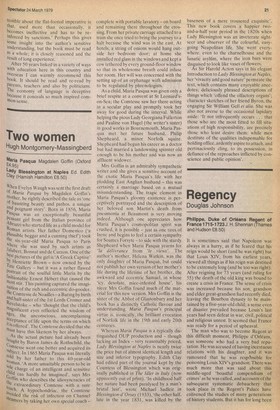Two women
Hugh Montgomery-Massingberd
Maria Pasqua Magdalen Goffin (Oxford 24.95) Lady Blessington at Naples Ed. Edith Clay (Ham ish Hamilton £8.50) When Evelyn Waugh was sent the first draft of Maria Pasqua by Magdalen Goffin's Mother, he rightly described the tale as 'one of haunting beauty and pathos, a unique and poignant story'. Born in 1856, Maria Pasqua was an exceptionally beautiful Peasant girl from the Italian province of Abruzzi who started life as a child model for Roman artists. Her father Domenico Ca Plausible beggar and a cunning thief') took the six-year-old Maria Pasqua to Paris where she was used by such artists as Jalabert, Bonnat and de Curzon. One of the ,best pictures of the girl is 'A Greek Captive' Henriette Brown — now owned by the Tate Gallery — but it was a rather flawed Portrait of the soulful little Maria by the fashionable Ernest Hebert that caused the Most stir. This painting captured the imagination of the rich and eccentric do-gooder, the Comtesse de Noailles — a Baring by birth and half-sister of the 1St Lords Cromer and Revelstoke — who 'thought that the child's Magnificent eyes reflected the wisdom of ages, the unconscious, uncomplaining c.eeptance of life upon the terms on which It is offered'. The Comtesse decided that she Must have this likeness by her always. , As the actual picture had already been u°ught by Baron James de Rothschild, the Comtesse went one better and acquired its SubJect. In 1865 Maria Pasqua was literally sold by her father to this 40-year-old woman. 'A more unsuitable person to be in sole charge of an intelligent and sensitive r.,ehli.d cars hardly be imagined', says Mrs `Joffin who describes the idiosyncracies of the extraordinary Comtesse with a sure tQueb. A hypochondriac, the Comtesse 4v0ided the risk of infection on Channel steamers by taking her own special coach — complete with portable lavatory — on board and remaining there throughout the cros sing. From her private carriage attached to a train she once tried to bring the journey to a halt because the wind was in the east. At hotels, a string of onions would hang out side her bedroom door; at home she installed red glass in the windows and kept a cow tethered by every ground-floor window so that its wholesome breath could infuse her room. Her will was concerned with the setting up of an orphanage with admission to be regulated by phrenologists.
As a child, Maria Pasqua was given only a brief respite at a convent at St Leonard'son-Sea; the Comtesse saw her there acting in a secular play and promptly took her away for good during the interval. While helping the pious Lady Georgiana Fullerton and Pauline von Hugel (the writer's sister) in good works in Bournemouth, Maria Pasqua met her future husband, Philip Shepheard, a minor Norfolk squire. Shepheard had begun his career as a doctor but had married a landowning spinster old enough to be his mother and was now an affluent widower.
Mrs Goffin is an admirably sympathetic writer and she gives a sensitive account of the exotic Maria Pasqua's life with her plodding East Anglian husband — this was certainly a marriage based on a mutual misunderstanding. The tragic element in Maria Pasqua's gloomy existence is perceptively portrayed and the description of her beloved son Martin's death from pneumonia at Beaumont is very moving indeed. Although one appreciates how Maria Pasqua's cosmopolitan spirit was crushed, it is possible — just as one tires of Irene and begins to feel a certain sympathy for Soames Forsyte — to side with the sturdy Shepheard when Maria Pasqua yearns for `la delivrance from 'le Vieux'. The author's mother, Helena Watkin, was the only daughter of Maria Pasqua, but could not publish her own version of her mother's life during the lifetime of her brother, the awkward and eccentric Samuel, in whose icy, desolate, mice-infested house', his niece Mrs Goffin found much of the material for this new version. Mrs Goffin is the sister of the Abbot of Glastonbury and her book has a distinctly Catholic flavour and understanding. Maria Pasqua's principal virtue is, ironically, the brilliant evocation of Norfolk life in the 19th and early 20th centuries.
Whereas Maria Pasqua is a typically distinguished OUP production and — though lacking an Index — very reasonably priced, Lady Blessington at Naples is nearly twice the price but of almost identical length and size and inferior typography. Edith Clay had edited part of the journal kept by the Countess of Blessington which was originally published in The Idler in Italy (now apparently out of print). 'In childhood half her nature had been paralysed by a man's brutal lust', wrote Michael Sadleir in Blessington-d'Orsay (1933), 'the other half, late in the year 1831., was killed by the baseness of a mere trousered exquisite'. This new book covers a happier twoand-a-half year period in the 1820s when Lady Blessington was an inveterate sightseer and observer of the colourful, easygoing Neapolitan life. She went everywhere, even to the charnelhouse and the lunatic asyltim, where the iron bars were disguised to look like vases of flowers. As Sir Harold Acton says in his elegant Introduction to Lady Blessington at Naples, her 'vivacity and good nature' permeate the text, which contains many enjoyable anecdotes; deliciously phrased descriptions of things which 'offend the olfactory organs'; character sketches of her friend Byron, the engaging Sir William Gell et alia. She was also not averse to the occasional lapidary aside: 'It not infrequently occurs . . . that those who are the most fitted to fill situations of high responsibility, are precisely those who least desire them: while men destitute of the qualities indispensable for holding office, ardently aspire to attach, and pertinaciously cling, to its possession, in defiance of the reproaches inflicted by conscience and public opinion'.


































 Previous page
Previous page